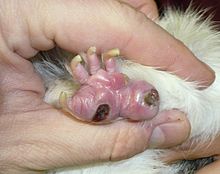
Bumblefoot (ulcerative pododermatitis) is a common bacterial infection and inflammatory reaction that occurs on the feet of birds, rodents, and rabbits.[1] It is caused by bacteria, namely species of Staphylococcus, Pseudomonas, and Escherichia, with S. aureus being the most common cause of the infection.[1] The aforementioned opportunistic bacteria occur naturally in the animal's environment, and infection occurs when one or a combination of these enters the body through a scrape or cut in the skin.[2]
Bumblefoot can take various forms, but it usually looks like an abscess-like swelling with a central, dark-colored scab that may or may not ooze.[3] Sometimes, this swollen bump contains pus or cottage cheese-like material.[3] Alternately, the swelling could contain a hard lump[3] when these materials harden, or if the abscess becomes impacted with substrate (e.g. soil, straw, etc.)[3] Bumblefoot may also present as redness, swelling, small red sores, and depending upon severity and length of time with the condition, lesions, cracks, or discoloration.[2]
Lameness puts more weight-bearing duty on an animal's strong leg(s); this leads to excessive pressure being placed on the good foot (or feet), which increases the chance of an abrasion occurring that could develop a bumblefoot infection.[2] Consequently, in cases of lameness, the good leg(s) should be examined for potential cuts and infections.[2] Overweight animals are more at risk of developing bumblefoot for the same reason; their extra weight causes excessive pressure on their feet.[2] However, the infection can usually be attributed to poor husbandry practices,[1][4] so is much more likely to occur in captive animals than in those in the wild. Ulcerative pododermatitis is referred to as "sore hocks" when it affects a rabbit and "bumblefoot" when it affects a bird.[1] The terms "sore hocks" and "bumblefoot" are used interchangeably when describing ulcerative pododermatitis in rodents.[1]
- ^ a b c d e Blair, Jennifer (2013). "Bumblefoot: A Comparison of Clinical Presentation and Treatment of Pododermatitis in Rabbits, Rodents and Birds". In Fisher, Peter G. (ed.). Select Topics in Dermatology. Veterinary Clinics of North America: Exotic Animal Practice. Vol. 16. Elsevier Health Sciences. pp. 715–736. doi:10.1016/j.cvex.2013.05.002. ISBN 978-0-323-18876-0. ISSN 1094-9194. PMID 24018034.
- ^ a b c d e Pitesky, Maurice (Spring 2014). "The Dirt on Bumblefoot" (PDF). Chicken Whisperer magazine. AcreAgeLife.com. Retrieved 2 September 2021.
- ^ a b c d Pesaturo, Janet (9 November 2013). "Bumblefoot treatment". www.OurOneAcreFarm.com. Janet Pesaturo. Retrieved 2 September 2021.
- ^ Pitesky, Maurice (2 August 2016). "The Dirt on Bumblefoot". Acreage Life. Heartland Communications Group. Archived from the original on 29 May 2018. Retrieved 20 March 2017.